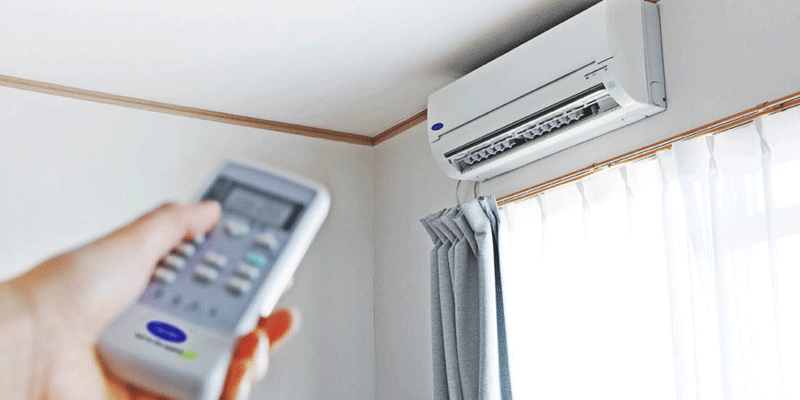
There are many choices when it comes to cooling your home. Window units, multi-split systems, single split systems, central ac–what’s the difference and what will work best for you?
Here we break down two popular types of air conditioning systems: window AC units and ductless mini-split systems. We’ll give a brief overview of each system and its main differences, followed by a comprehensive analysis outlining the pros and cons of both systems.
Window Air Conditioning Units
AC window units (pictured below) are portable air conditioning units that can be set up in an open window. They’re ideal for cooling small rooms or specific areas where you don’t want to install a permanent unit. The downside is these types of units tend to be expensive and can’t cool a whole home.
Ductless Mini-Split Systems
A ductless mini-split system doesn’t need a central unit to work, which means there is no need for ductwork. These systems are also called “splits” because they consist of one outdoor unit and up to five indoor units connected together by tubing that carries refrigerant back and forth from the outdoor unit.
Ductless split systems are ideal for cooling large spaces such as rooms or entire floors of a house but tend to be more expensive upfront compared to window units. In addition, some homeowners may prefer the comfort of air circulating through their home with an AC system that has central air vents in each room.
This article will break down the main differences between AC window units and ductless mini-split systems. We’ll also provide information on which one would be a better choice for homes in Austin, TX.
First, let’s consider what many homeowners are concerned about: cost and efficiency.
Window Units Cost-efficiency: As previously mentioned, window units are cheaper to purchase initially but can end up costing more to operate. If your home or apartment has an older HVAC unit that runs at speeds lower than 10 (meaning it uses less energy), then using a window air conditioner will probably increase your utility bill.
On the other hand, if your home is newer with an HVAC system running at speeds higher than 10 (which uses less energy), then using a window unit may not increase your utility bill.
Ductless Split Systems Efficiency-cost: Installation of ductless split systems is an upfront cost, but these systems run at speeds higher than ten and can help decrease your monthly utility bill. Standard AC units use about 5 to 7 percent of your home’s electricity, and the rest comes from heating and lighting. But since mini-split systems require very little electricity to run, they’ll lower your overall household power consumption and save you money in the long run.
Main Differences
Window Units:
– Easy to move around and install
– Available for all climates, including warm and humid regions due to the continuous outside airflow
– Inexpensive start-up cost but can be expensive to operate because your HVAC system may have to work harder in order to keep you cool if the window unit is not designed for colder weather.
Ductless Split Systems:
– Ideal for large spaces such as an entire floor or room
– The outdoor compressor requires a place to vent hot air so it cannot be placed near plants, trees, or other objects that could impede its flow. Also, it’s recommended this system should not be installed on a second story because of possible noise pollution from the outdoor unit.
However, there are many kinds of ductless split systems to accommodate different types of homes. For example, a hybrid AC system will have an outside compressor and traditional ductwork, which allows the indoor units to be placed anywhere in your home.
– Installation is expensive but can help decrease monthly power bills by running at speeds higher than 10.
The main difference between these two systems is that AC window units are best for cooling small rooms or specific areas, whereas ductless split systems are ideal for cooling large spaces such as entire floors of your house.
Now let’s compare the pros and cons of each system:
Window Units Pros:
– Can be installed quickly without any hassle
– Portable; you can move them around easily
Cons:
– Not strong enough to cool large spaces (unless you install multiple units)
– Some models are not designed for colder weather, so they cannot be used in certain areas
Ductless Split Systems Pros:
– Can cool large spaces such as entire floors of a house more efficiently than window units
– A permanent solution with no moving parts
Cons:
– Installation is expensive and might require some professional installation
– Cannot be installed on upper levels because the outside compressor needs a place to vent hot air, which can cause noise pollution.
Which is Best for Your Home?
If you’re interested in saving the most money, then it’s wise to choose ductless mini-split systems. You can increase your home’s efficiency by running at higher speeds than AC window units and using less power overall. Since these units are permanently installed in one area of your home, they don’t need to work as hard when cooling since they don’t have to vent hot air elsewhere as window units do.
Final Verdict:
AC window units are best used when cooling small rooms or specific areas. If your goal is to get the most efficient air conditioner, then go with ductless mini-split systems that will lower your overall utility costs in the long run. And if you’re interested in saving money on installation, purchase a portable air conditioner. If you are located in or around the Austin, Texas area and need help with choosing a unit for your home, reach out to the experts at Austin AC for assistance. The contractors have years of experience and can help with most of your heating and cooling needs.
